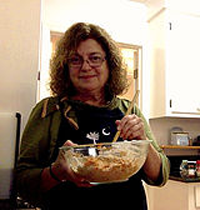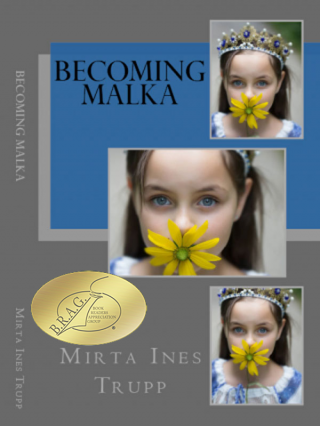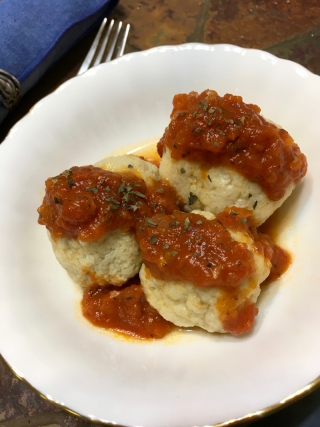Foodie Lit: A genre of novel and memoirs filled with food stories and recipes
Each month, I’ll share the magic of a good Foodie Lit read and one of its recipes.
Cooking and recipes in novels or memoirs take us into the mind of the character or narrator and brings us into the book’s kitchen to see, smell and share the lives within.
Here’s to cooking and reading!
With Love, The Argentina Family; Becoming Malka
Mirta Ines Trupp
Mirta Innes Trupp searches for family history and her identity in her memoir, With Love, The Argentina Family and in her historical fiction, Becoming Malka, works that she describes as the story of a Russian, Argentinian, American and Jewish immigrant.
Teachers couldn’t pronounce her name and students couldn’t figure out what group she belonged to. “Here at home, I struggled to find myself within the American tapestry. I was acutely aware of how different we seemed to be from others. Not only were we immigrants, but we didn’t quite fit the mold. … I couldn’t find my niche.”
Mirta’s journey becomes literary when she writes With Love, The Argentina Family. When her father begins working for Pan Am, Mirta frequently travels back and forth between the Argentina family and her US home. Where does she belong? Who is she? Her identity struggles are internal and historical: she is multicultural and yet cannot be compartmentalized. Guided by her extended Argentina and US family, Mirta becomes fiercely patriotic and simultaneously pulled to Argentina.
Mirta told me, “As a child, growing up away from my extended family of grandparents, aunts, uncles and cousins, I had a mish-mash of rituals and traditions in my brain. I couldn’t differentiate between Argentine customs, Yiddish baba maises (literally grandma stories) or Russian superstitions.”
Mirta’s story defies many stereotypes. She feels that these umbrella terms are narrow and “more often than not, label and corral people into groups that are simply inaccurate. Clichés about the color of skin or the choice of foods are, still to this day, floating about in our society. Spanish-speaking peoples are not all ‘brown.’ Not everyone eats tacos or spicy foods…The idea of Jews being of various ethnicities, color or creeds is a foreign concept to some. It is, in fact, very similar to the Latino misconception, because a person can be “black, brown, or white” and come from a Spanish speaking nation. Jews can be “black, brown or white” and speak Hebrew, Yiddish or Ladino.”
In Becoming Malka, main character Molly Abramovitz travels to Moscow and then Odessa to research the generation before Argentina. With the help of a the Queen of 8 Wands, magical (and mythical) Tarot card, Molly winds up in 1900 in the household of her great-grandmother, Malka, for whom she was named. Perfect for the Young Adult crowd, this historical novel is a search for Molly/Mirta’s family. Wonderful descriptions of fashion, dances, food and superstitions abound (Don’t stand in the threshold of a room, for example) and the ever-present Anti-Semitism is shown, which eventually forces the family to leave for Argentina. Confused about her Jewish identity, Molly explores Judaism in her time travel. And like the author, she becomes proud of who she is and is determined to learn more.
In both books, food is a center at celebrations. Mirta’s family were proud to bring together their diverse cuisines. “The women in my family were amazing cooks- none better than my own mom, of course! …We do eat today much as we ate growing up. Weekends are still famous for Argentineasados (BBQ-gaucho style) and flan (crème caramel) with dulce de leche (a dense, creamy caramelized milk spread). Jewish holidays wouldn’t be Jewish holidays without kreplach, kugel and knishes. Brisket is not traditional in Argentina- my family would prepare different types of roasts….We love to eat ñoquis (gnocchi)and milanesa (breaded, thin slice of prime beef from the peceto, round roast cut) or the nalga (eye of round) a.k.a. cotoletta alla milanese because Argentine food is very much Italiano.”
Mirta shares a favorite family recipe for Passover: Matzah balls with Tuco. I have to admit I was a bit skeptical with this previously unknown recipe but, boy! This was fabulous! Try it with your seder or because you want to try a traditional matzah ball recipe a la Argentina!
Mirta’s Matzah Balls with Tuco
Try an Argentinian twist on the traditional matzah balls. Tuco is an Argentine pasta sauce, not as tomato-y as we are used to here in the United States. It is usually made with some sort of beef or chicken, as the juices of the meat provide the sauce with a rich, full-bodied flavor.
Serves 4
3 tablespoons olive oil
1 yellow onion, peeled and chopped
1 clove garlic, peeled and finely chopped
1 green bell pepper finely chopped
1-2 carrots, peeled and grated
1 14.5-ounce can tomato sauce
1 14.5-ounce can crushed tomatoes
1 6-ounce can tomato paste
1/2 cup stock
1 bay leaf
1 teaspoon paprika
Italian seasonings: 1/4 teaspoon each basil, thyme, marjoram and oregano
or to taste
Salt and pepper
- Follow your favorite matzah ball recipe, making 12 matzah balls the size of a golf ball. Prepare, boil and set aside in a casserole dish.
- Add oil to sauce pan and warm briefly. Add onions, garlic and bell pepper in saucepan over medium heat until soft. Reduce heat to medium low and add crushed tomatoes. Simmer for 5 minutes.
- Add carrot and tomato sauce to mixture. Stir in tomato paste, stock, bay leaf and seasonings. Continue to simmer for an additional 30 minutes or until you are happy with the consistency. Add more stock if tuco is too thick. Purée with an immerser if you wish to have a smoother texture.
- Place matzah balls in a serving dish and pour tuco over them. Garnish with chopped parsley, oregano or chives on top. If you like to grate some Parmesan cheese to garnish, use a vegetable or pareve stock.
- Refrigerate or freeze extra tomato sauce for future use.
B’tayavon! Bon appetite!
Be sure to check all of Susan’s wonderful reviews and recipes at FOOD FOR THOUGHT





Mirta hits the nail on the head when she talks about corralling people into inaccurate groups. My cousins are Mexican and Irish, while I am Bohemian, German and Irish. Too much of our heritage gets lost when we label people too easily.
Thanks for the recipe. It sounds delicious.
So many of us are from more than one country, as you are. A great diversity and hat refuses to be put into any box. I totally agree with you Terri! And the matzah balls con tuco is delicious!
I am going to try this recipe this weekend – I am not the “chef” you are Susan so wish me luck!